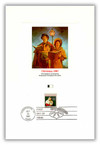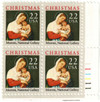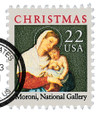
# 2367 - 1987 22c Traditional Christmas: Madonna and Child
U.S. #2367
1987 22¢ Madonna and Child
Traditional Christmas
- 21st Traditional Christmas stamp
- Pictures a portion of a 1560 painting by Giovanni Battista Moroni
- Second year in a row Christmas stamps produced at definitive size
Stamp Category: Commemorative
Series: Traditional Christmas
Value: 22¢, first-class rate
First Day of Issue: October 23, 1987
First Day City: Washington, DC
Quantity Issued: 528,790,000
Printed by: Bureau of Engraving and Printing
Printing Method: Photogravure
Format: Panes of 100 in sheets of 800
Perforations: 11
Why the stamp was issued: For use on holiday mail.
About the stamp design: This was Bradbury Thompson’s 13th Madonna and Child stamp. It pictures a portion of the 1560 painting A Gentlemen in Adoration Before the Madonna, by Italian portrait artist Giovanni Battista Moroni. The painting is part of the collection at the National Gallery of Art in Washington, DC.
Special design details: This was the second year in a row that both Christmas stamps were produced in definitive sizes to save costs on paper, printing time, ink, and other factors.
First Day City: The First Day ceremony for this stamp was held in the auditorium in the East Building of the National Gallery of Art. It had become a tradition at this point – this was the fourteenth Traditional Christmas stamp issued there, whose artwork hangs in its galleries.
About the Traditional Christmas Series: In 1966, the Post Office issued its first Madonna and Child stamp, a 15th century painting by Flemish painter Hans Memling. The stamp was very popular and over 1.1 billion were printed. This led the Post Office to issue another traditional Christmas stamp in 1968, this time picturing the Angel Gabriel. In 1969, they went back to more contemporary holiday subjects before finally deciding in 1970 to issue one Traditional Christmas stamp and one Contemporary Christmas stamp. Their decision proved popular and they’ve continued to issue both Traditional and Contemporary Christmas stamps ever since.
History the stamp represents: Giovanni Battista Moroni lived in northern Italy, in the foothills of the Alps. He was known for his portraits of nobility, soldiers, and clergy. Some experts consider him one of the greatest Italian portrait painters of the sixteenth century.
In addition, Moroni also painted religious themes. He was at the council of Trent in 1546, when the Protestant church formally split from the Catholic Church. He painted altar pieces during the time of the council and followed the Catholic doctrine and taste for art in the following years.
U.S. #2367
1987 22¢ Madonna and Child
Traditional Christmas
- 21st Traditional Christmas stamp
- Pictures a portion of a 1560 painting by Giovanni Battista Moroni
- Second year in a row Christmas stamps produced at definitive size
Stamp Category: Commemorative
Series: Traditional Christmas
Value: 22¢, first-class rate
First Day of Issue: October 23, 1987
First Day City: Washington, DC
Quantity Issued: 528,790,000
Printed by: Bureau of Engraving and Printing
Printing Method: Photogravure
Format: Panes of 100 in sheets of 800
Perforations: 11
Why the stamp was issued: For use on holiday mail.
About the stamp design: This was Bradbury Thompson’s 13th Madonna and Child stamp. It pictures a portion of the 1560 painting A Gentlemen in Adoration Before the Madonna, by Italian portrait artist Giovanni Battista Moroni. The painting is part of the collection at the National Gallery of Art in Washington, DC.
Special design details: This was the second year in a row that both Christmas stamps were produced in definitive sizes to save costs on paper, printing time, ink, and other factors.
First Day City: The First Day ceremony for this stamp was held in the auditorium in the East Building of the National Gallery of Art. It had become a tradition at this point – this was the fourteenth Traditional Christmas stamp issued there, whose artwork hangs in its galleries.
About the Traditional Christmas Series: In 1966, the Post Office issued its first Madonna and Child stamp, a 15th century painting by Flemish painter Hans Memling. The stamp was very popular and over 1.1 billion were printed. This led the Post Office to issue another traditional Christmas stamp in 1968, this time picturing the Angel Gabriel. In 1969, they went back to more contemporary holiday subjects before finally deciding in 1970 to issue one Traditional Christmas stamp and one Contemporary Christmas stamp. Their decision proved popular and they’ve continued to issue both Traditional and Contemporary Christmas stamps ever since.
History the stamp represents: Giovanni Battista Moroni lived in northern Italy, in the foothills of the Alps. He was known for his portraits of nobility, soldiers, and clergy. Some experts consider him one of the greatest Italian portrait painters of the sixteenth century.
In addition, Moroni also painted religious themes. He was at the council of Trent in 1546, when the Protestant church formally split from the Catholic Church. He painted altar pieces during the time of the council and followed the Catholic doctrine and taste for art in the following years.












